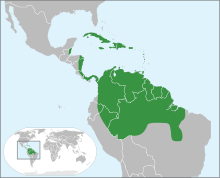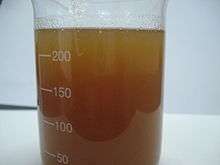Carapa
Carapa is a genus of flowering plants in the mahogany family, Meliaceae. These are trees up to 30 meters tall occurring in tropical South America, Central America,[1] and Africa. Common names include andiroba and crabwood.
| Carapa | |
|---|---|
| Scientific classification | |
| Kingdom: | Plantae |
| Clade: | Tracheophytes |
| Clade: | Angiosperms |
| Clade: | Eudicots |
| Clade: | Rosids |
| Order: | Sapindales |
| Family: | Meliaceae |
| Subfamily: | Cedreloideae |
| Genus: | Carapa Aubl. |
| Species | |
|
See text | |

Diversity
The list of species within this genus is still under discussion. Generally recognized species are:
- Carapa guianensis (andiroba, crabwood): Amazon Region, Central America, Caribbean
- Carapa megistocarpa (tangare): Ecuador
- Carapa procera (African crabwood, kowi, okoto): West Africa, the Congos
Other proposed species:
Uses
The timber is important, and oil is produced from the seeds. The name andiroba is from Nheengatu nhandi rob, meaning "bitter oil". Carapa guianensis produces oil similar to neem oil.
The oil contained in the almond andiroba is light yellow and extremely bitter. When subjected to a temperature below 25 °C, it solidifies producing a consistency like that of petroleum jelly. The oil contains olein, palmitine and glycerin.
Andiroba oil is one of the most commonly sold medicinal oils in the Amazon. It is also used to repel mosquitoes by forming an oilseed cake into balls and burned, or mixed with annatto (Bixa orellana) and formed into a paste applied topically to protect the body from mosquito bites.[5]
Andiroba oil is extracted from light brown seeds collected from beaches and rivers, where they float after being shed by the trees or from the forest ground.

References
- Hogan, C. M. 2008. Isthmian-Atlantic moist forests. Encyclopedia of Earth, World Wildlife Fund, National Council of Science and the Environment.
- Forget P. M.; et al. (2009). "A new species of Carapa (Meliaceae) from Central Guyana" (PDF). Brittonia. 61 (4): 366–74. doi:10.1007/s12228-009-9090-z. Archived from the original (PDF) on 2014-01-10. Retrieved 2013-07-24.
- Kenfack D.; Peréz A. J. (2011). "Two new species of Carapa (Meliaceae) from western Ecuador". Systematic Botany. 36 (1): 124–28. doi:10.1600/036364411X553207.
- Kenfack D (2011). "Carapa vasquezii (Meliaceae), a new species from western Amazonia" (PDF). Brittonia. 63 (1): 7–10. doi:10.1007/s12228-010-9163-z.
- Miot HA, Batistella RF, Batista Kde A, Volpato DE, Augusto LS, Madeira NG, Haddad V Jr, Miot LD (2004). "Comparative study of the topical effectiveness of the Andiroba oil (Carapa guianensis) and DEET 50% as repellent for Aedes sp". Rev Inst Med Trop Sao Paulo. 46 (5): 253–6. doi:10.1590/s0036-46652004000500004. PMID 15517027.